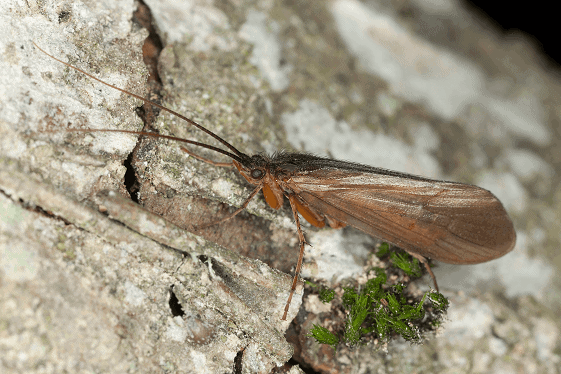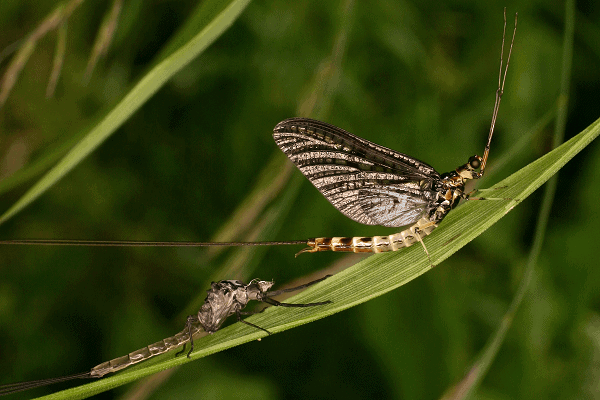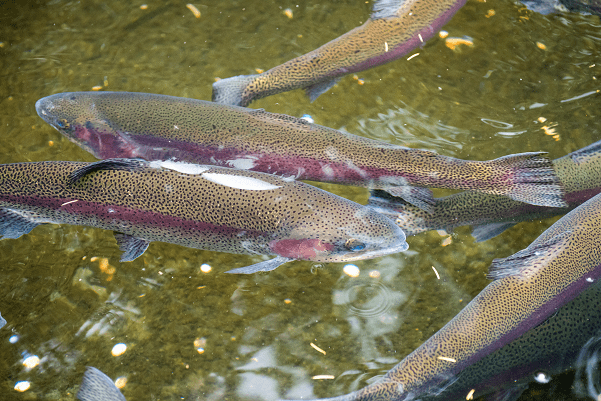What Do Rainbow Trout Eat in the Wild?

In the wild rainbow trout eat a variety of insects, both adult and larval stages. Crayfish and other crustaceans, leeches, fish eggs and other fish.
Insects of Many Varieties are a Staple of Rainbow Trout.
Arguably the most important food source for rainbow trout are aquatic insects.
insectsSuch as Caddisfly mayfly stonefly midges spend the vast majority of their life cycle in the water. These insects love oxygen rich water and can often be found right in the Riffle.
The Pools that form at the end of fast moving water offer rainbow trout a virtual conveyer belt of food floating down the river.
Knowledge of what the local rainbow trout are feeding on can be very useful When selecting your bait or lure.This is what fly fisherman refer to as matching the hatch. Meaning you try to make your fly match the currently hatching aquatic insects or most common food source during that season.
A good way to determine what rainbow trout are eating is to examine the rocks and reeds along the shoreline for emerging insects. You can often find the discarded skins of recently emerged nymphs clinging to the rocks. A close examination of the shallows and under rocks will often yield collections of small minnows freshwater shrimp and aquatic insects.
Stoneflies

Stoneflies only have three stages egg, nymph, and finally the adult stage they have no pupa stage. Stonefly larvae can be quite large ranging from half an inch all the way up to an inch and a half. The nymph stage of stoneflies can last up to 2 years. There are a multitude of different colored nymph patterns to imitate the stage. Such as bead head stonefly, golden stones and Kaufmann Stonefly.
When the nymph stage is complete it will haul itself up onto the shore, molt and then emerges as an adult fly ready to complete the life cycle.
Caddisflies


Caddisflies transition from egg to larva to Pupa and then finally emerge as adult flies. There are Two types of larvae ones that build cases and ones that do not. The case building caddisfly larvae secretes a type of silk that bonds together sticks and small Pebbles in order to form a protective case for the insect. The other type of larva will seek refuge underneath rocks in the fast-moving stream.
The larval stage is by far the longest stage for caddisflies they can remain as larvae for as long as two years. Of course there are flies that imitate both the cased and the other version of the larval stage. When the larvae is ready to pupate The cased varieties will seal off their case and pupate inside there. Once fully developed they will chew their way out of the case and float up to the surface where they will molt and emerge as adults.
The final flying stage of Adult caddisflies are often imitated with the elk hair Caddis . This last stage does not last long as the insects do not feed after emerging. They basically breed, lay eggs, and then die. The resulting eggs hatch in a few weeks and the cycle begins all over again.
Mayflies


The mayfly life cycle begins as an egg that hatches into a nymph, the aquatic version of the insect. This cycle can last a year or two before they emerge from the water. Two of the most common wet flies used to imitate this nymph stage are the pheasant tail and hare’s ear nymph.
When mayfly nymphs emerge from the water this stage is known as the dun stage where they float on the water and allow their wings time to dry so they can take flight. The final stage in fly-fishing parlance is called a spinner stage. This is when the dun molts its skin and assumes its final adult form.
Terrestrial Insects, Fair Game for Rainbow Trout
besides aquatic insects rainbow trout also eat Terrestrial insects such as ants, grasshoppers or crickets that fall in the water. When examining the shore line at various times of the year you will find these insects in abundance. Chances are it might be worth trying to imitate these in the water.
I once went rainbow trout fish fishing and there was a frenzied group of blue damselflies breeding. I was at that lake for two days and I tried cheese, powerbait, worms, spoons, jigs and everything else that I had on hand. I didn’t even get a bite because none of these matched the current forage. The only thing these fish were interested in taking it that particular time was blue damselflies so it always pays to be prepared and have a wide assortment of flies or lures on hand.
Fish and Fish Eggs
Rainbow trout will consume the eggs of other fish and their own species. They will eat trout, salmon and white fish eggs. In addition to the eggs they will eat other fish of various sizes Including other trout and yellow perch. They can become more piscivorous as they age.
Spin casting crankbaits in various colours is an effective way of catching rainbows. Anglers using a fly rod have a multitude of streamers (wet fly) to imitate fish. It often pays off to have a varied assortment of fishing gear for trout on hand.
Leeches
Leeches are also readily devoured by rainbow trout. A fly pattern used to imitate this is the wooly bugger either in brown, black or Olive. Looking through the pools and overturning rocks in your fishing spot will give you a good idea of what the local leech population looks like. You can then present your wooly bugger in either brown, black or olive. These fly patterns can also be used spin casting.
Crayfish and Other Crustaceans
Crayfish and scuds or freshwater shrimp can also form part of the diet of rainbow trout.
Both crayfish and scuds have various fly patterns. Alternatively for the spin fisherman there are soft baits that imitate crayfish.
Understanding the natural diet of the species you are targeting can greatly increase your chances of landing a fish. While this article does reference a lot of fly patterns these options are also open to anglers using spinning gear. Please check out my article on using flies with a conventional rod.
Sources:

